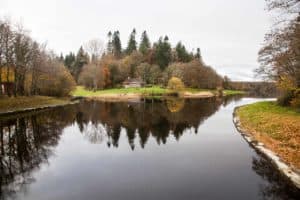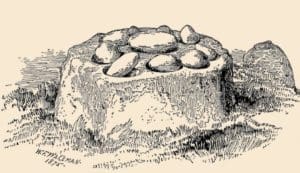Conquering Carrauntoohil: The Highest Mountain in Ireland

Updated On: April 15, 2024 by Raghda Elsabbagh
Are you enthralled by the majesty of towering peaks and yearning for a heart-pounding trek in the Emerald Isle? If so, we are kindred spirits as we are also utterly bewitched by the allure of scaling summits—notably Carrauntoohil, the highest mountain in Ireland, standing imposingly at an impressive 1,038 metres.
In this article, we’ll guide you through practical tips about its various exhilarating hiking routes to satisfy your adventurous spirit, preparation essentials to ensure safety, and unforgettable picturesque gems just waiting for explorers like you. Eager to triumph over Carrauntoohil? Let’s embark on our thrilling escapade!
Table of Contents
Overview of the Macgillycuddy’s Reeks Mountain Range

Nestled in the heart of Ireland’s southwest lies the majestic Macgillycuddy’s Reeks, a rugged mountain range that cradles the highest mountain in Ireland—Carrauntoohil. Stretching across County Kerry on the Iveragh Peninsula in Ireland, the Reeks boast a captivating tapestry of craggy peaks, deep valleys, and sweeping landscapes. The Gaelic name “Macgillycuddy’s Reeks” adds a touch of mystery, echoing old tales as whispers of ancient legends dance through the wind-swept valleys.
Naming and Ownership
Carrauntoohil gets its name from the Irish language. “Corrán Tuathail”, which translates to “Tuathal’s sickle,” refers to an ancient mythological figure named Tuathal. The ownership of Carrauntoohil lies with the state, and it is part of Killarney National Park.
The Formation of Carrauntoohil
Carrauntoohil’s story is written by geology’s hand over centuries. Long before we roamed this green island was a time when powerful forces beneath the Earth’s surface clashed and moulded the very foundations of the land. It was here, amidst this geological ballet, that Carrauntoohil took its first form.
The mountain owes its rise to the collision of tectonic plates, where unimaginable pressures gave birth to the Macgillycuddy’s Reeks. Over countless millennia, these forces sculpted the landscape, chiselling the peaks and valleys that make the region a visual symphony of nature’s artistry.
Carrauntoohil itself, standing proudly at 1,038 metres, emerged due to the relentless dance between uplift and erosion. Glaciers, once formidable architects of the land, played a crucial role in shaping the rugged contours we see today. Their slow, icy advance and retreat carved out corries and arêtes, leaving behind the distinctive features that define this majestic mountain’s silhouette.
Unique Features and Characteristics of the Mountain

Carrauntoohil wears its geological history like a badge of honour. As you ascend its slopes, you’ll encounter a mosaic of rocks reminiscent of ancient times. Among the mountain’s notable features is the narrow and thrilling knife-edge ridge known as the “Beenkeragh Ridge.” This razor-sharp crest tests the adventurers’ bravery, offering an exhilarating expedition for those seeking a memorable ascent.
The summit, kissed by the ever-changing Irish sky, offers panoramic views stretching as far as your eye can see—rolling green hills, shimmering lakes, and the distant shimmer of the Atlantic Ocean. On a clear day, you might catch a glimpse of neighbouring counties, inviting you to marvel at the patchwork quilt of Ireland beneath your feet.
Diverse Ecosystems on Carrauntoohil
The highest mountain in Ireland is a haven for diverse ecosystems that call its slopes home. As you ascend, the landscape undergoes a mesmerising transformation, from the lush greenery of the lower slopes to the rocky crags and snow patches at higher elevations.
Venture into the embrace of Carrauntoohil, and you’ll discover a world where hardy plant life clings to rocky crevices, undeterred by the challenging conditions. Wildflowers, such as the purple saxifrage and mountain avens, paint the landscape with bursts of colour, defying the harsh winds that sweep across the highest reaches.
Keep a keen eye; you might spot the elusive peregrine falcon soaring gracefully overhead, a master of the mountain skies. The Irish hare, with its distinctive winter coat, adds a touch of charm to the rocky slopes. In this high-altitude realm, nature has carved out niches for resilient species that have adapted to thrive in the shadow of Ireland’s loftiest peak.
Climbing and Hiking on Carrauntoohil
When hiking this mountain, you will traverse steep and rugged terrain. You will navigate rocky slopes, challenging ridges, and ever-changing weather conditions. Getting to the top is a physical and mental challenge, demanding resilience and determination. Yet, with each step, the landscape unfolds, revealing hidden valleys, shimmering lakes, and the allure of breathtaking vistas of other peaks in the range that will make every step worth it! So, if you love the outdoors, don’t miss out on this climb!
Hiking Routes on Carrauntoohil
Carrauntoohil offers various routes, with varying difficulty levels, that wind their way to the summit, each offering a unique perspective on the mountain’s grandeur. Consider your fitness level and experience when selecting a route. Popular options include the Devil’s Ladder, the Hag’s Glen, and the more challenging Beenkeragh Ridge.
Devil’s Ladder
Devil’s Ladder is a direct route to the summit and is often chosen by hikers. It involves ascending a steep gully and offers panoramic views. Caution is advised, especially on the descent, as loose scree can make it challenging.
- Distance: Approximately 11 km (round trip).
- Difficulty: Moderate to Strenuous.
- Time to complete: 4 to 6 hours.

Zig-Zag Route (Bothar na Gige)
This route is favoured for its zig-zagging path up the mountain’s eastern face, offering a challenging yet manageable climb for those seeking a more direct ascent.
- Distance: Approximately 12 km (round trip).
- Difficulty: Strenuous.
- Time to complete: 4 to 6 hours.
Brother O’Shea’s Gully
This is an alternative route to the summit, less frequented than Devil’s Ladder. It offers a challenging yet rewarding hike with less foot traffic than the more popular routes.
- Distance: Approximately 10 km (round trip).
- Difficulty: Moderate to Strenuous.
- Time to complete: 4 to 6 hours.
Hags Glen Route
Hags Glen provides a scenic approach to Carrauntoohil for those seeking a gentler climb, passing by Lough Gouragh. The trail offers varied terrain and is considered less challenging than other routes.
- Distance: Approximately 13 km (round trip).
- Difficulty: Moderate to Strenuous.
- Time to complete: 5 to 7 hours.
Beenkeragh Ridge
This route involves traversing the Beenkeragh Ridge, which connects Carrauntoohil with Ireland’s second-highest peak, Beenkeragh. It offers breathtaking views but includes exposed and challenging sections.
- Distance: Approximately 14 km (round trip).
- Difficulty: Strenuous.
- Time to complete: 6 to 8 hours.
Coomloughra Horseshoe
The Coomloughra Horseshoe is a challenging and rewarding circuit encompassing several peaks, including Caher and Carrauntoohil. The route typically starts and finishes at the Hydro Road near Cronin’s Yard. Hikers ascend the Zig-Zag path to reach the ridge and continue along the horseshoe-shaped route, taking in the breathtaking views of the stunning Coomloughra Valley.
The prominent peaks along the Coomloughra Horseshoe include Caher (third-highest in Ireland), Caher West Top (fifth-highest in Ireland), and Carrauntoohil. The descent often involves descending via the Heavenly Gates, a steep and rocky section leading back to the valley.
- Distance: Approximately 12 km (round trip).
- Difficulty: Strenuous.
- Time to complete: 6 to 8 hours.
Regardless of the chosen path, every route to Carrauntoohil promises a blend of challenge, beauty, and a profound sense of accomplishment. Check with the Killarney Tourist Office for updated information before embarking on your adventure.
13 Safety Measures and Guidelines for Hiking on Carrauntoohil
Climbing Carrauntoohil is a rewarding adventure, but it comes with its own challenges. As adventurers set foot on Carrauntoohil’s trails, safety becomes paramount in the dance between man and mountain. Here are some practical tips to help you prepare and make the most of your ascent:
1. Choose the Right Route

Consider your fitness level, experience, and the course’s difficulty level before selecting a route.
2. Check Weather Conditions
Before embarking on your climb, check the weather forecast, as the highest mountain in Ireland is known for its erratic weather. The conditions can change rapidly, so be prepared for rain, wind, and potential temperature drops.
3. Start Early
Hit the trail early in the day to reach the summit in daylight and descend before darkness falls. This also helps you avoid crowds and increases your chances of experiencing clearer weather.
4. Wear Appropriate Clothing
Layer your clothes to accommodate changing weather conditions throughout the day. Wear sturdy, waterproof hiking boots with good traction to safely navigate challenging terrain. Bring a waterproof jacket and pants. A hat and gloves are also essential, especially at higher altitudes.
5. Pack Essentials
Carry a backpack with all the essentials such as water, snacks, navigation tools like maps and compasses, and a fully charged mobile phone. It’s advisable to pack a first aid kit, in case of any minor injuries along your way, a whistle, and a headlamp in case your hike extends into the evening. Remember your camera too, because you’ll want to capture the stunning views!
6. Be Mindful of Navigation

Familiarise yourself with the trail markers. Visibility can change quickly, and having navigation tools, like a GPS device, will help you stay on course.
7. Stay Hydrated and Energised
Climbing Carrauntoohil can be physically demanding. Carry enough water to stay hydrated and energy-rich snacks to stay fueled throughout the hike.
8. Use Hiking Poles
Consider using hiking poles to provide stability, especially on steeper climb sections and to reduce strain on your knees during descents.
9. Accompany Local Guides
Consulting with local guides for the latest trail conditions is advisable. Local guides provide not just expertise but also a wealth of stories about the mountain’s history and Irish folklore.
In the ancient annals of Irish myth, the Carrauntoohil becomes a setting for stories of heroes and mythical creatures. Legends speak of giants roaming the valleys, their footsteps imprinting the rugged landscape.
10. Inform Someone of Your Plans
Before you climb, inform a friend or family member of your plans, including your chosen route and expected return time. It’s important that someone knows your whereabouts in case of emergencies. It’s also recommended to hike with a friend.
11. Know Your Limits
Be honest about your fitness level and experience. If you find a section too challenging, it’s okay to turn back. Safety should always be the top priority.
12. Take Breaks and Stay Safe
During the climb, take breaks and pace yourself to avoid exhaustion. Finally, always stay on the designated trails and be mindful of potential hazards like steep drops or slippery terrain.
13. Respect the Environment
Follow Leave No Trace principles and responsible trekking practices. Stay on designated paths to minimise the impact on the fragile ecosystem of Carrauntoohil to ensure that the natural beauty of Carrauntoohil remains unspoiled for generations to come. Avoid picking plants or disturbing wildlife. Remember, climbing Carrauntoohil is a memorable experience, and it’s a shared responsibility to safeguard the integrity of this natural wonder.
The Panoramic Views from the Summit
Even though the trails leading to the summit offer challenges, they also offer rewards in equal measure. Reaching the summit of Carrauntoohil, the highest mountain in Ireland, is a physical triumph and a visual feast that unfolds in every direction. From the peak, a 360-degree canvas of Ireland’s beauty stretches beneath your gaze. To the south, the shimmering expanse of the Atlantic Ocean meets the horizon, while to the north, the emerald landscape unfolds like a patchwork quilt. Rolling green hills, glinting lakes, and neighbouring peaks contribute to a breathtaking panorama that captures the essence of Ireland’s untamed grandeur.
With its ever-changing moods and dramatic vistas, Carrauntoohil is a muse for photographers and artists alike. As the sunlight dances on its rocky slopes or clouds cloak its summit in mystery, the mountain offers numerous moments that beg to be captured. Photographers frame the iconic silhouette against the canvas of changing skies. At the same time, artists find inspiration in the interplay of light and shadow on the rugged terrain.
Carrauntoohil’s Impact on Tourism
As the highest mountain in Ireland, Carrauntoohil beckons adventurers from across the globe to witness the unrivalled beauty that unfolds from its summit. The area bustles with hikers and the energy of curious travellers. Local tourism has flourished as thrill-seekers and nature enthusiasts flock to explore the trails that lead to this majestic peak. Bed-and-breakfasts nestled in nearby villages extend a warm Irish welcome, catering to those seeking to immerse themselves in the enchanting landscapes surrounding Carrauntoohil.
Environmental Conservation Efforts in the Area
While Carrauntoohil proudly stands as the highest mountain in Ireland, it is not impervious to the effects of human presence. The popularity of this natural wonder brings with it a double-edged sword. Increased foot traffic, improper waste disposal, and the unintentional trampling of delicate vegetation pose challenges to the mountain’s fragile ecosystem.
This has prompted a critical question: How do we welcome adventurers without compromising the very environment they come to admire? Striking a delicate balance between tourism and environmental sustainability is the key.
Conservation Initiatives to Preserve the Environment
A collective effort is underway to safeguard the pristine beauty of Carrauntoohil. Local organisations, guided by a commitment to their natural heritage, work tirelessly alongside conservationists to maintain the delicate balance of the mountain’s fragile ecosystems.
Conservationists collaborate to monitor the health of the mountain’s biodiversity, striving to protect the unique flora and fauna that make Carrauntoohil a biological treasure.
Sustainable tourism practices, such as designated trails, help minimise ecological impact. Reforestation projects aim to restore areas impacted by human activity. At the same time, education and awareness programs impart the importance of responsible trekking and Leave No Trace principles.
However, we all need to embrace the responsibility to be guardians of this natural wonder. As we venture to conquer its peaks, it’s vital to be mindful of the impact our footsteps can leave. Preserving Carrauntoohil’s ecosystems is a shared responsibility that starts with us so that we ensure that future generations can experience its natural splendour.
Conquer the Highest Mountain in Ireland
Conquering Carrauntoohil is a thrilling adventure for outdoor enthusiasts. Whether you’re a seasoned mountaineer or a first-time hiker, standing atop Carrauntoohil is truly a humbling experience. The views from its summit are more than a visual spectacle—they are a timeless embrace of Ireland’s majestic landscapes. So grab your gear, prepare yourself, and get ready to conquer the heights of Carrauntoohil!
FAQs
1. Can anyone climb Carrauntoohil?
Climbing or mountaineering on Carrauntoohil is an outdoor adventure for those who love hiking and exploration. But remember, it can be tough, so good fitness will help!
2. Are there other big mountains in Ireland to explore?
Yes! Besides Carrauntoohil, many hikers enjoy peak climbing on Mount Brandon, Lugnaquilla and Galtymore, which are part of various mountain ranges throughout Ireland.
3. How does Carrauntoohil compare to other peaks in Britain?
Carrauntoohil might look small compared to some mountains like Ben Nevis in Britain, but don’t be fooled! Carrauntoohil provides an unrivalled wilderness experience.
4. Is it safe to hike Irish mountains alone?
While climbing any Irish mountain could offer a thrilling adventure, having company makes this journey more fun and often safer, especially when tackling more arduous paths towards the summit.
5. When is the Best Time to Hit the Trails?
Plan your adventure during summer when the weather is more favourable, trails are safer, and skies are clearer.






